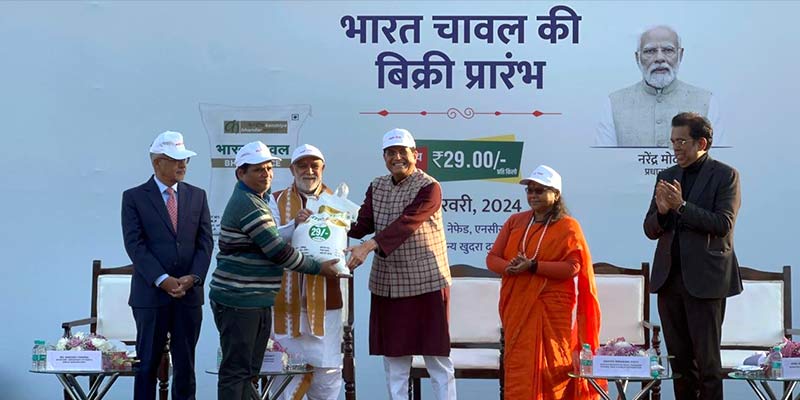- India
- Feb 07
Centre launches sale of ‘Bharat Rice’ at Rs 29/kg
• Union Minister Piyush Goyal launched sale of ‘Bharat Rice’ at a subsidised rate of Rs 29 per kilogram.
• The launch of retail sale of ‘Bharat Rice’ will increase supplies in the market at affordable rates and will help in continued moderation of prices of this important food item.
• ‘Bharat Rice’ will be available at all physical and mobile outlets of Kendriya Bhandar, National Agricultural Cooperative Marketing Federation of India (NAFED) and National Cooperative Consumers’ Federation of India (NCCF). It will be expanded to other retail outlets and e-commerce platforms.
• The Food Corporation of India (FCI) will provide 5 lakh tonnes of rice to two cooperatives — NAFED and NCCF — as well as retail chain Kendriya Bhandar in the first phase.
• ‘Bharat’ brand rice will be sold in 5 kg and 10 kg bags.
• Bharat Atta is already being sold by these agencies at a rate of Rs 27.50 per kg.
• Similarly, Bharat Dal (chana dal) is also being sold at a rate of Rs 60 per kg, along with onions at Rs 25 per kg. Apart from these three agencies, state-controlled cooperatives of Telangana, Maharashtra and Gujarat are also involved in retail sale of Bharat Dal.
• With the launch of sale of ‘Bharat Rice’, consumers can get rice, atta, dal as well as onions from these outlets at fair and affordable prices.
What is Kendriya Bhandar?
• The Central Government Employees Consumer Cooperative Society Ltd, New Delhi, operating in the name of Kendriya Bhandar was set up in 1963 as a welfare project for the benefit of the central government employees.
• It is functioning under the aegis of ministry of personnel, public grievances & pensions.
• The society endeavours to serve the central government employees and the general public by providing quality goods of daily needs at reasonable prices through its retail stores.
• The range of items which Kendriya Bhandar provides include consumer goods, grocery items, stationery and medicines, etc.
• It is functioning on a “no profit and no loss” concept basis.
• It is registered under Multi-State Cooperative Societies Act, 2002.
• The Society operates a network of 150 stores/branches in many states.
• It has been able to maintain competitive prices for various products sold by it as compared to those prevailing in the market. In fact, selling prices prevailing in Kendriya Bhandar now are deemed as the benchmark in the market.
• For better quality control, a full-fledged Quality Control Department is in place for monitoring the product quality and for making improvements on an ongoing basis. Packed grocery items are sold after pre-testing in the laboratory.
What is NCCF?
• The National Cooperative Consumers’ Federation of India Limited (NCCF) is the national level consumer cooperative society having its area of operation in the entire country.
• It is an organisation to promote consumer cooperative movement in the country and aspires to facilitate the voluntary formation and democratic functioning of cooperatives, based on self-reliance and mutual aid for overall economic betterment and financial autonomy.
• The main objectives of the NCCF are to provide supply support to the consumer cooperatives and other distributing agencies for distribution of consumer goods at reasonable and affordable rates besides rendering technical guidance and assistance to the consumer cooperatives.
• It was registered in October 1965.
• The headquarters is situated in New Delhi.
• It operates through a network of 24 branch offices located in different parts of the country.
• NCCF is registered under the Multistate Cooperative Societies Act, 2002 and functions under the ministry of consumer affairs.
What is NAFED?
• National Agricultural Cooperative Marketing Federation of India Ltd (NAFED) is an apex organisation of marketing cooperatives for agricultural produce in India.
• It was established in 1958 under the Multi-State Cooperative Societies Act.
• NAFED was founded with the goal to promote the trade of agricultural produce and forest resources across the nation.
• There are over 900 members in NAFED, represented by chief executives of apex level marketing/consumer cooperative/other national level federations, state level marketing/ tribal/commodity federations and primary cooperative marketing/processing societies.
• Agricultural farmers are the main members of NAFED.
• The activities of NAFED add to the betterment of agriculture and post harvest of the produce.
• NAFED procures stocks directly from the farmers in regulated mandis in open auction through the cooperative infrastructure thereby providing them a ready market, fair price and preventing their exploitation at the hands of private traders.
• Also, whenever there is a glut in market due to bumper production when prices tend to crash, NAFED undertakes procurement at the Minimum Support Price (MSP) under the Price Support Scheme in case of 16 notified commodities (pulses, oilseeds, copra, dehusked coconut, cotton) thereby providing remunerative prices to farmers for their produce.
The objectives of the NAFED are:
i) To organise, promote and develop marketing, processing and storage of agricultural, horticultural and forest produce.
ii) Distribution of agricultural machinery, implements and other inputs.
iii) Undertake inter-state, import and export trade, wholesale or retail as the case may be.
iv) To act and assist for technical advice in agricultural production for the promotion and the working of its members, partners, associates and cooperative marketing, processing and supply societies in India.
• NAFED also plays a crucial role in price stabilisation of essential commodities like onion and pulses through creation of national buffer on the direction of the government of India.
Manorama Yearbook app is now available on Google Play Store and iOS App Store

